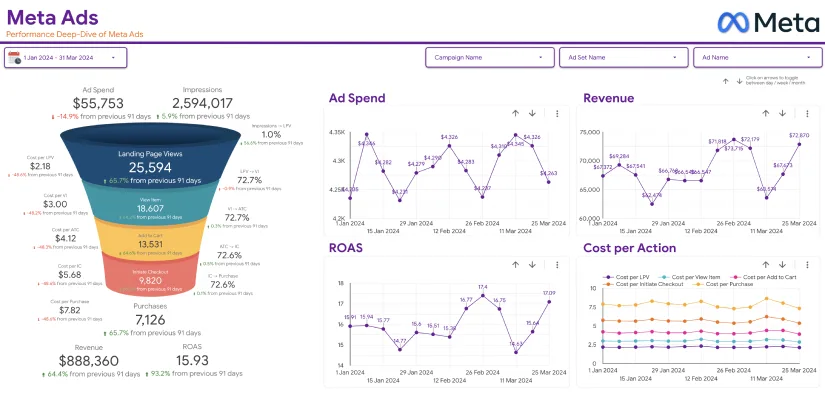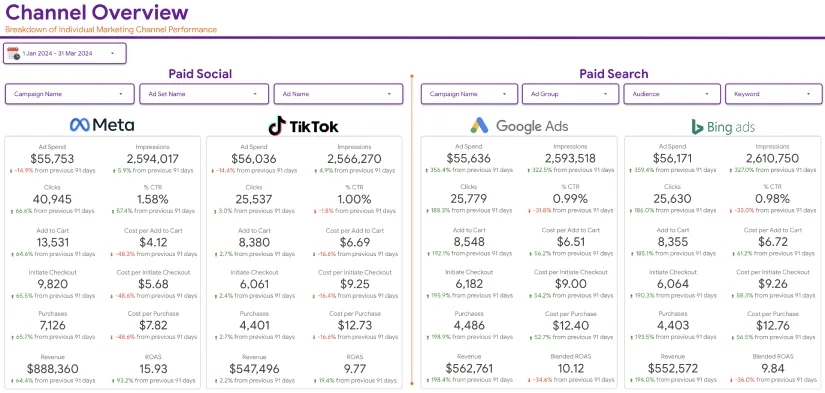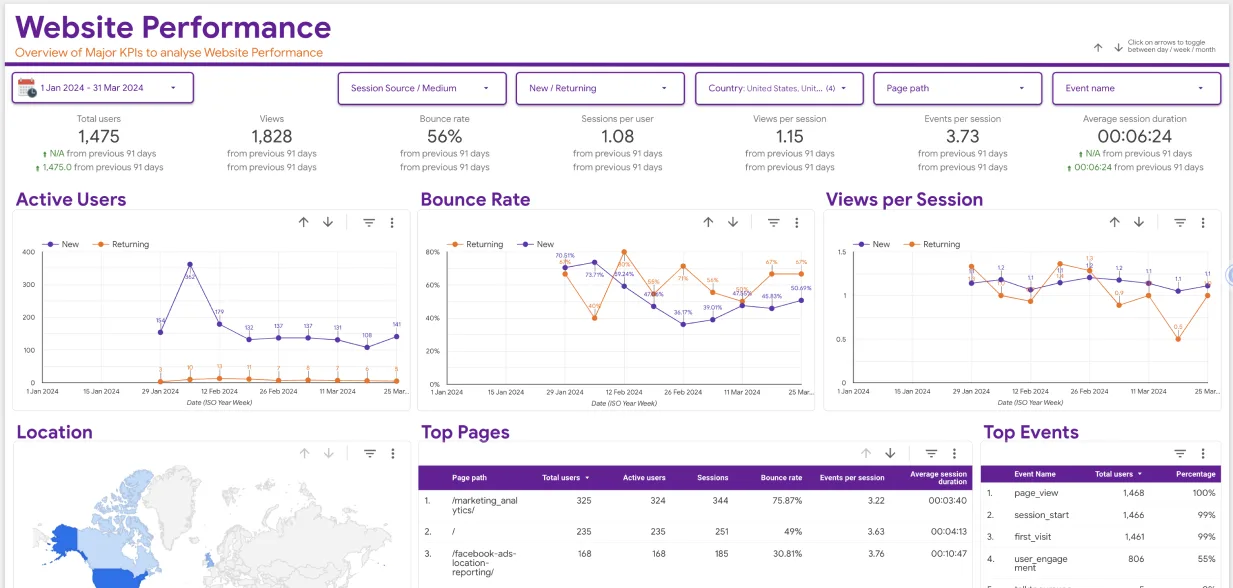One question that perplexes website owners and digital marketers is “How often should SEO analytics be reviewed?” Unfortunately, there is no one-size-fits-all answer. There are several factors based on which the review frequency varies for every website.
But just because there is no simple answer to this question doesn’t mean you should overlook the review. After all, any effective SEO strategy is built on a foundation that emphasizes regular reviews and adjustments based on ongoing insights.
In this article, we’ll take a detailed look at the importance of SEO analytics, types of SEO analytics, how often you should review SEO analytics and more.
What is SEO Analytics and Why is it Important?
SEO or Search Engine Optimization is the process through which you improve your website’s visibility in search engines. SEO analytics is the process through which you collect, measure, and analyze the impact of your SEO efforts.
By leveraging SEO analytics, businesses can make informed decisions to optimize their content, boost search rankings, and ultimately bring more relevant traffic to the website.
Reviewing SEO analytics allows you to-
Track Performance
Know the keywords that are bringing traffic, how people are using your website, and which pages are most popular.
Identify Opportunities
Regular analysis allows you to identify trends, uncover gaps, and discover new content ideas and keyword opportunities.
Refine SEO Strategy
SEO is significantly influenced by algorithm updates, competitor moves, and market trends. Regular analytics review helps you stay ahead.
Improve User Experience
By analyzing user behavior, it is possible to make decisions that can help make the website more user-friendly, ultimately bringing more traffic.
Measure ROI
SEO analytics also helps business owners and marketers evaluate the return on investment for their SEO activities and allocate resources more effectively.
What are the Key SEO Metrics You Must Review?
Before talking about how often should SEO analytics be reviewed, it is essential to know the key metrics that should be monitored and what they mean. Take a look-
1. Traffic Metrics

- Organic Traffic- Number of people visiting your website through search engines.
- Referral Traffic- People visiting your website after clicking on your link on other websites.
- Direct Traffic- People who directly visit your website by typing your URL into their web browsers.
2. Keyword Performance
- Keyword Rankings- The keywords you’re targeting and their position in SERPs (Search Engine Results Page).
- Click-Through Rate (CTR)- The percentage of people who click on your website’s link after viewing it in the SERPs.
- Search Volume- How often a keyword is searched within a specific timeframe, like daily, weekly, monthly, etc.
3. On-Page SEO Metrics
- Bounce Rate- The percentage of people who leave your website after viewing a single page.
- Average Session Duration- The average time visitors spend on your website.
- Pages Per Session- The number of pages a visitor visits in a single session.
4. Conversion Metrics
- Action Completion- The number of website visitors who complete the desired action, like making a purchase or filling out a lead form.
- Conversion Rate- The percentage of website visitors who complete the required action.
- Average Order Value (AOV)- The average amount spent by visitors on a transaction.
5. Technical SEO Metrics
- Page Load Time- How quickly your website pages load – a critical factor impacting user experience and search rankings.
- Crawl Errors- Website errors that prevent search engines from visiting and indexing your pages.
- Mobile Usability- How well your website performs on mobile devices.
What are the Different Types of SEO Analytics?
Now that you know the basic SEO analytics metrics you must review, let us go a step further and understand the different types of SEO analytics. These analytics can be divided into three broad categories- leading, lagging, and real-time. Here’s what they mean-
1. Leading SEO Analytics Indicators
As the name suggests, leading indicators are ones that can predict future performance. In other words, these are indicators that can tell you how well your SEO efforts are likely to perform, enabling you to make proactive adjustments.

These indicators come in handy for setting strategic direction and anticipating trends before they fully materialize. For instance, keyword ranking is a popular leading SEO analytics indicator. If your keywords are consistently moving up in SERPs, it is likely that you might witness an increase in organic traffic.
Some other leading SEO indicators are-
- Search volume trends for relevant keywords
- Content engagement metrics, like time spent on a page, social shares, comments, etc.
- Backlink acquisition rate or the rate at which you acquire new backlinks can signal ranking improvements and better DA (Domain Authority)
2. Lagging SEO Analytics Indicators
The results of your past SEO efforts can be determined with the help of lagging indicators. While you might want to focus on leading indicators that can help you improve future performance, it is equally important to measure the effectiveness of past strategies as they can help you make adjustments to what you’re currently doing.
For instance, organic traffic is a lagging indicator of how well your website has performed in the SERPs. An increase in organic traffic is usually a result of effective SEO strategies implemented in the past.
Here are a few other popular lagging SEO indicators-
- Conversion rate or the number of people completing the desired action
- DA or Domain Authority, which predicts how well a website is ranking in SERPs
- Revenue from organic search as it signals the financial impact of your SEO efforts
3. Real-Time SEO Analytics Indicators
Real-time indicators offer immediate insights into how your website is performing at any given moment. You should regularly review these metrics so that you can quickly react to changes, like sudden traffic drops or spikes, and make on-the-go adjustments to your SEO strategy.
For instance, real-time traffic data that you can access from a platform like Google Analytics allows you to see how many people are on your website at any given moment and the traffic source.
Some other real-time SEO indicators are-
- Live conversion tracking to assess the immediate impact of the changes made to your website or marketing efforts
- Website health monitoring to ensure everything is working smoothly
How Often Should SEO Analytics be Reviewed?

Now to the main question, how often should SEO analytics be reviewed? Based on the metrics and indicators discussed above, here is a general guideline-
1. Daily Reviews
- Traffic Monitoring- Larger websites, e-commerce stores, news websites, etc., should monitor the traffic metrics daily to track any sudden spikes or drops.
- Keyword Rankings- If the keywords you’re targeting are highly competitive, it is wise to track them daily to identify fluctuations and adjust strategies accordingly.
- Website Health- Keep checking for technical issues such as downtime, crawl errors, or significant drops in page speed on a daily basis.
2. Weekly Reviews
- Organic Traffic Trends- On a weekly basis, you must review overall traffic trends to understand how your site is performing.
- Keyword Performance- Track keyword rankings, CTR, and search volume for targeted keywords.
- Content Performance- Analyze the content pieces that are performing well and ones that should be optimized further.
3. Bi-Weekly Review
- Conversion Metrics- Assess how well your website is converting visitors into customers or leads.
- User Behavior- Check bounce rate, session duration, and pages per session to understand how users are interacting with your website.
4. Monthly Reviews
- Comprehensive Traffic Analysis- Take a deeper dive into all traffic sources, including organic, referral, and direct traffic, to identify trends and potential areas for improvement.
- Content Audit- Review the performance of your content, including engagement metrics, page views, social shares, etc., to better understand what resonates with your audience.
- Backlink Profile- Assess your backlink profile to ensure your website is attracting high-quality, relevant links and disallowing harmful ones.
- Technical SEO Audit- Conduct a technical SEO audit to identify and fix issues affecting your website’s performance, including duplicate content, broken links, or slow page load times.
5. Quarterly Reviews
- Competitive Analysis- Review what your competitors are doing with regard to SEO. Have they made any significant improvements or changes?
- Strategy Assessment- Analyze the effectiveness of your overall SEO strategy. Are you achieving your KPIs? What improvements should be made?
- Long-Term Performance- Analyze long-term trends to identify consistent growth areas and opportunities for new strategies.
6. Annual Reviews

- Yearly Performance Reviews- Reflect on the overall year’s performance. Which strategies worked best? What didn’t? Use this information to make strategies for the next year.
- Goal Setting- Set new SEO goals based on performance data and industry trends. Define clear objectives for traffic growth, keyword rankings, and conversions.
- Budget Allocation- Assess your SEO budget and allocate resources to the most effective strategies and channels.
Conducting SEO Analytics Review
If you’ve read the entire post, you now know how often should SEO analytics be reviewed. As there is no single answer to this question, you must take aspects like business type and size, industry dynamics, resource availability, and algorithm updates into consideration to further improve SEO performance.
Until then, the guidelines discussed above should be adequate for maintaining a solid foundation for your SEO strategy. Based on the results, you can then make adjustments to the review frequency and ensure consistent performance monitoring.






